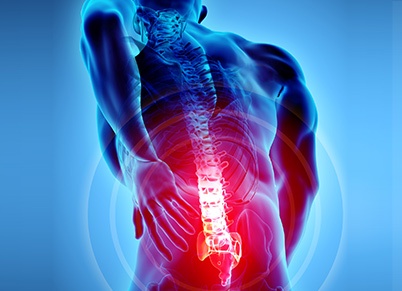
Low back pain is often a common symptom of many disease conditions and the back pain may range from simple or dull pain to sudden and sharp pain. If the pain persists for a few days, it is acute pain whereas if it continues
for more than 3 months, it is considered as chronic pain. In most cases, low back pain may resolve without any treatment, however, if it persists for more than 3 days, medical intervention is necessary.
Low back pain may be a common symptom in various conditions such as appendicitis, aneurysms, kidney diseases, kidney and bladder infections, ovarian disorders, pregnancy, nerve root syndromes such as sciatica, herniated
discs, spinal stenosis, musculoskeletal problems, osteomyelitis, spondylitis, tumors, spine injuries, fractures, and many more.
Low back pain can be alleviated with RICE (Rest, Ice, Compression, and elevation) treatment, pain relievers, non-steroidal anti-inflammatory drugs, corticosteroids, and physical therapy. However, certain conditions causing severe pain may require surgical treatment. Treating the underlying conditions offers relief from back pain.
One of the common causes of low back pain is a low back strain. Low back strain or lumbar strain occurs when the muscle or the tendon in the lower back gets stretched or torn. It is caused by lifting heavy objects or overload, sitting or standing for a longer time, direct blow over the area, or sports such as basketball, baseball, or golf that involve sudden twisting of the lower back, can also lead to strain.
The risk factors such as excess low back curvature, weak abdominal muscles, and forwardly tilted pelvis can increase the risk of this injury. The common symptoms include low back pain that radiates down to the buttocks; inflammation of the soft tissues that surround the muscles; stiffness in the lower back; restricted movements; inability to maintain correct posture; muscle spasms; and pain which continues for a longer period.
Dr. Vengurlekar will perform a physical examination and take a brief medical history to diagnose your condition. Additional tests such as an X-ray and MRI scan may be required to confirm the injury and provide necessary treatment.
Conservative treatment methods include:
- Rest: You should take complete rest for 1-3 days, as more damage could result from putting pressure on the back. Prolonged bed rest should also be avoided as it leads to loss of muscle strength and makes the muscles stiff which will aggravate pain and discomfort. Hence bed rest should not be continued for more than 48 hours.
- Ice packs can be applied to the injury which will help to diminish swelling and pain. Ice should be applied over a towel to the affected area for 15-20 minutes four times a day for several days. Never place ice directly over the skin.
- Braces or a belt might be used to support the back while the healing takes place.
- Medications that may be prescribed include non-steroidal anti-inflammatory drugs to reduce pain and inflammation. Other medicines such as muscle relaxants control muscle spasms. These medicines often cause sedation; therefore, consult Dr. Vengurlekar to discuss the type of muscle relaxants for you.
- Vengurlekar may also suggest a rehabilitation program. It consists of stretching and strengthening exercises, pelvic traction, gentle massages, and ice or heat therapy to improve your condition. It helps to control the pain, strengthen the abdominal muscles, and also speeds up the recovery which allows you to return to weight-bearing activities.
Some of the preventive measures which can help prevent back strain include:
- Doing warm-up exercises before the start of any physical activity or sports and taking short breaks in between the activity.
- Ensure that you use correct lifting techniques such as squatting to lift a heavy object.
- Ensure that you maintain a proper posture while sitting and standing.
- If you are overweight or obese, it can strain the back muscles. Hence, it is advised that you lose some weight and maintain a healthy diet.
- You must exercise every day as it improves spine stability and also prevents extra stress on your back.
Top Scottsdale Pain Management Expert Dr. Vengurlekar recognizes the serious long-term issues associated with back pain. It can leave individuals incapable of working and managing everyday tasks, not to mention the pain and suffering that often comes from back issues. For the populations of older people, many did not have the advantage of more developed medical research at younger ages in order to practice habits to reduce back pain in the future.
Dr. Vengurlekar sees hundreds of patients every year who suffer from back pain, due to years of sitting improperly at their office desks. Luckily, it is never to late to adjust posture habits, and even the most unfocused individuals can see improved posture, by consciously following a few posture tips.















